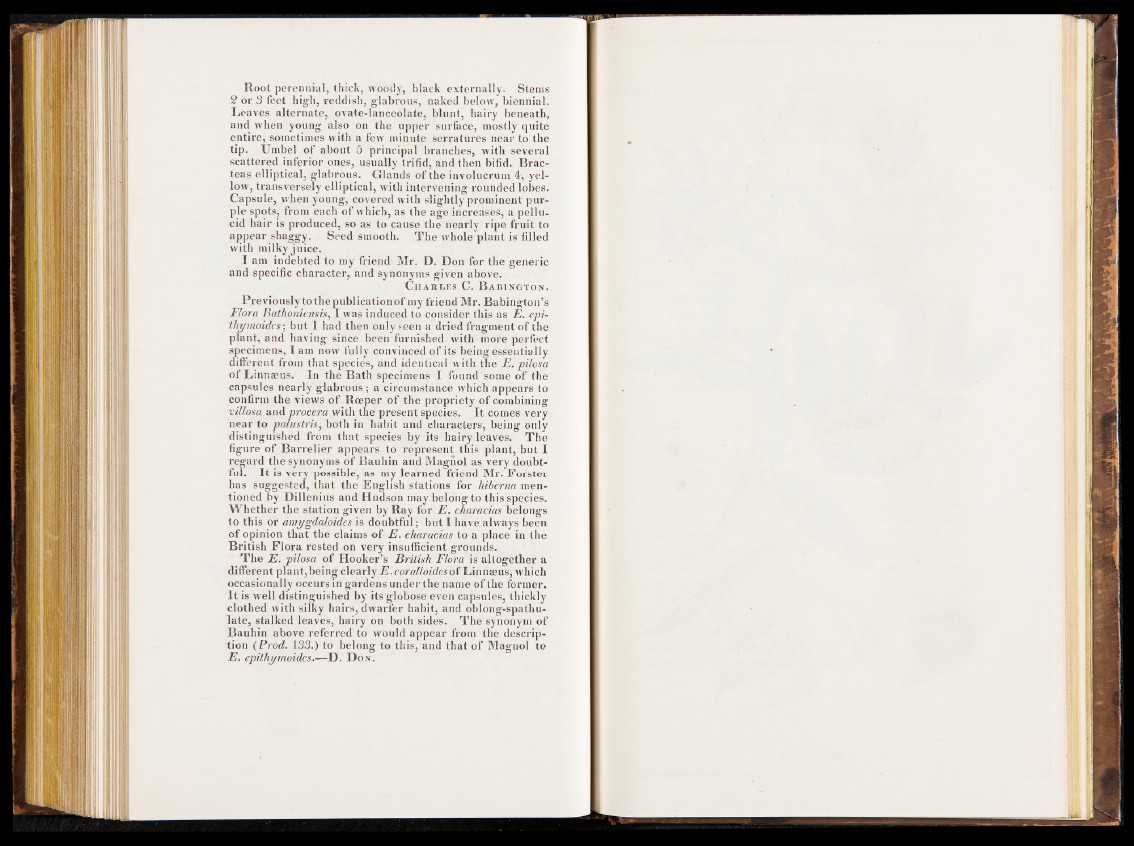
Root perennial, thick, woody, black externally. Stems
2 or 3 feet high, reddish, glabrous, naked below, biennial.
Leaves alternate, ovate-lanceolate, blunt, hairy beneath,
and when young also on the upper surface, mostly quite
entire, sometimes with a few minute serratures near to the
tip. Umbel of about 5 principal branches, with several
scattered inferior ones, usually trifid, and then bifid. Brac-
teas elliptical, glabrous. Glands of the involucrum 4, yellow,
transversely elliptical, with intervening rounded lobes.
Capsule, when young, covered with slightly prominent purple
spots, from each of which, as the age increases, a pellucid
hair is produced, so as to cause the nearly ripe fruit to
appear shaggy. Seed smooth. The whole plant is filled
with milky juice.
I am indebted to my friend- Mr. D. Don for the generic
and specific character, and synonyms given above.
Charles C. B abington.
Previously tothepublicationof my friend Mr. Babington’s
Flora Bathoniensis, I was induced to consider this as E. epi-
thymoides; but I had then only seen a dried fragment of the
plant, and having since been furnished with more perfect
specimens, I am now fully convinced of its being essentially
different from that species, and identical with the E. pilosa
of Linnaeus. In the Bath specimens I found some of the
capsules nearly glabrous ; a circumstance which appears to
confirm the views of Rceper of the propriety of combining
villosa and procera with the present species. It comes very
near to palustris, both in habit and characters, being only
distinguished from that species by its hairy leaves. The
figure of Barrelier appears to represent this plant, but I
regard the synonyms of Bauhin and Maghol as very doubtful.
It is very possible, as my learned friend Mr. Forster
has suggested, that the English stations for liiberna mentioned
by Dillenius and Hudson may belong to this species.
Whether the station given by Ray for E. characias belongs
to this or amygdaloides is doubtful; but I have always been
of opinion that the claims of E. characias to a place in the
British Flora rested on very insufficient grounds.
The E. pilosa of Hooker’s British Flora is altogether a
different plant, being clearly E.coralloides of Linnaeus, which
occasionally occurs in gardens under the name of the former.
It is well distinguished by its globose even capsules, thickly
clothed with silky hairs, dwarfer habit, and oblong-spathu-
late, stalked leaves, hairy on both sides. The synonym of
Bauhin above referred to would appear from the description
l Prod. 133.) to belong to this, and that of Magnol to
E. epithymoides.—D. Don.